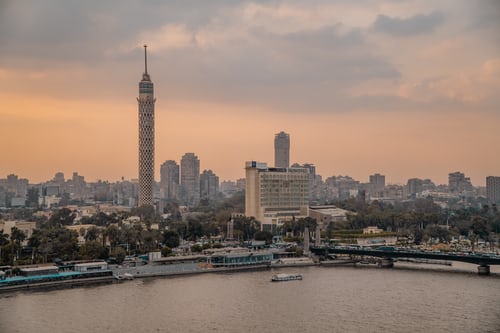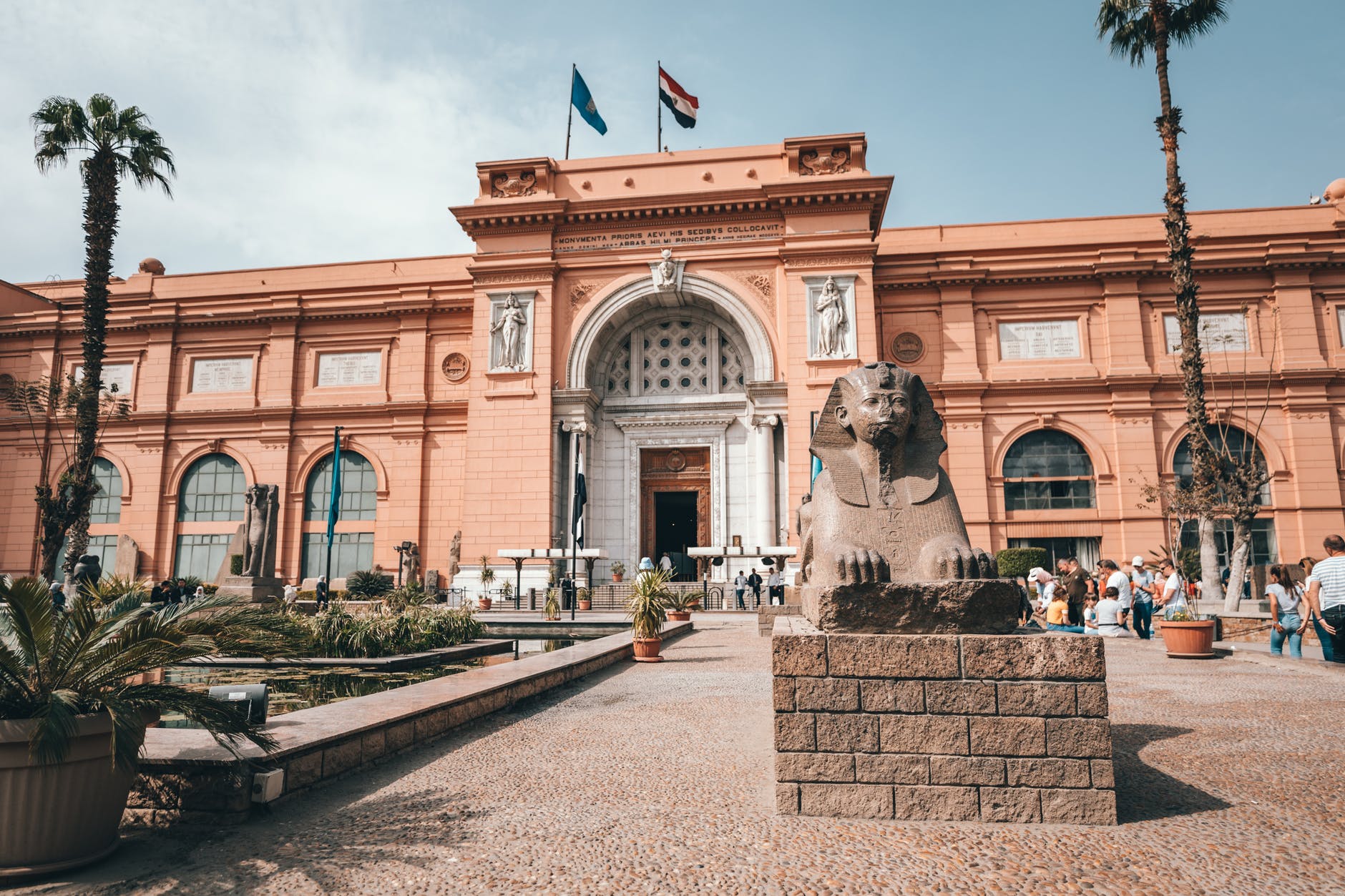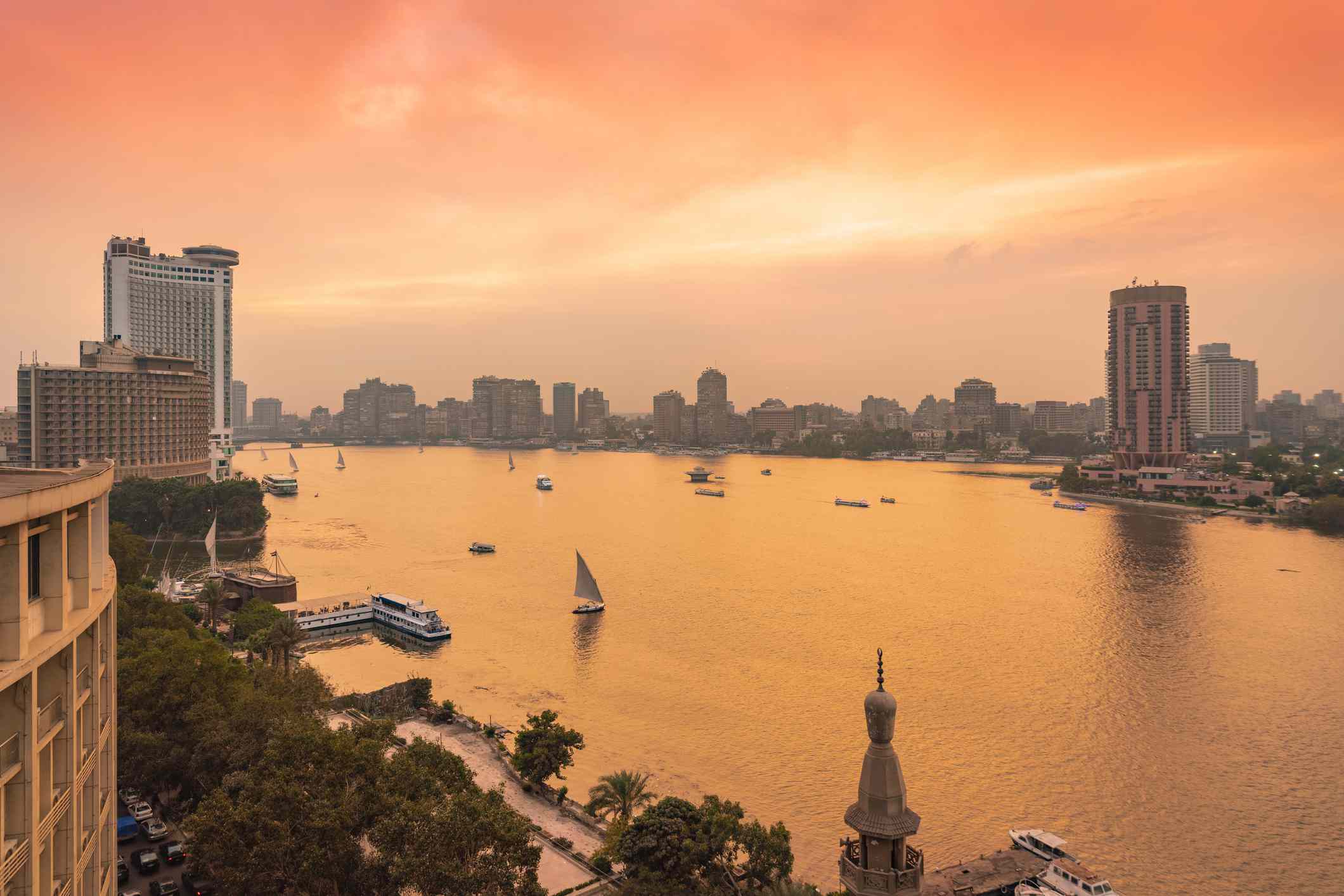To a land where there is no shortage of serendipity. We're in Egypt. It's Cairo.
Cairo, straddling the Nile, is the biggest city in North Africa and the biggest in the Middle East.
Middle East.
It's the capital of Egypt and one of the leading cities in Islam. With about 20 million people in greater Cairo, it's bursting at the seams and pulsing with energy. And this energy will carry us to some of Cairo's greatest sights and most vibrant neighborhoods.
We'll explore the back streets local style, help chisel a tombstone, greet the ancient Sphinx, marvel at King Tut's gold, drop in on a mosque...
"Buy one, two free today. Cheapy-cheap". Haggle with a gauntlet of eager merchants, have dinner at home with a family, and marvel at the pyramids. In the southeast of the Mediterranean, Egypt, 50% bigger than Texas, gathers its 100 million people mostly along the Nile River.
We'll explore its leading city, Cairo, and finish at the Pyramids of Giza.
Cairo is a fascinating clash between traditional and modern, religious and secular, East and West. While its chaos can be exasperating, it can also be a rewarding challenge for the adventurous traveler.
Cairo's downtown is modern [Horns blaring] and can feel European.
Streets, squares, and grand buildings are reminders of the country's colonial past from the 19th and early 20th centuries.
The riverfront throbs with energy -- stately bridges busy with traffic, fancy riverside restaurants, and towering apartment complexes.
The Nile is still the lifeblood of the city, sprawling endlessly on both sides.
The heart of Cairo is Tahrir Square. It's long been ground zero for the people's spirit. If there's a demonstration going on -- and there have been massive ones in recent years -- it's likely here.
Cairo has been a leading city in the Muslim world. And, today, Cairo's known as the City of a Thousand Minarets.
Stepping into Al-Hussein Mosque, like any neighborhood mosque, you'll find worshipful tranquility.
It's believed that resting here invigorates the soul.
There's more intensity around the adjacent shrine, believed to contain a sacred relic -- the head of Al-Husayn ibn Ali, a grandson of the prophet Muhammad.
In a mosque, men and women worship separately. As praying can be physical, with lots of bending over, it's considered more respectful to allow women their own space.
I find that a respectful tourist is welcome to be a part of the scene.
Along with minarets, you'll see church spires, especially in Cairo's Coptic Quarter. While Egypt is predominantly Muslim, today, about 10% of the country is Christian. The Egyptian, or Coptic, Church actually predates Islam by six centuries.
Because they worship in an orthodox style, stepping into a Coptic mass is like going back in time.
The faithful believe that, when Mary, Joseph, and baby Jesus escaped Herod by fleeing to Egypt, this very spot is where they took refuge.
The people you see on the streets are the living descendants of one of the oldest, and greatest, civilizations in history.
The people of today's Egypt represent the latest chapter in a story that goes back 5,000 years. Even if you don't understand its long and complicated history, just observing how old and new come together is rewarding to the traveler.
Egypt's heritage goes back twice as far as ancient Rome. And "ancient" Egypt, that's what draws the tourists. The iconic sights of Egypt, 4,000 or 5,000 years old, are basically buildings and art for dead people. Back then, they believed you" could" take it with you and your big challenge to be sure your body "and" your valuables survived the journey into the afterlife. That's why, if you had the power and the money, you'd lock everything up in a big tomb a pyramid. These are the most famous, the Pyramids of Giza. But the oldest pyramid is actually nearby, at Saqqara, the tomb of the king, or pharaoh, named Zoser. This structure, which marked his tomb, is a step pyramid.
Dating from around 2,600 BC, it's a century older than its more famous sisters at Giza.
This first-ever towering stone structure is more than just a grave marker. With an innovative stacking of layers, it provided a new way to glorify a king, creating a stairway to eternity. A visit to Cairo's Egyptian Museum helps bring the country's many ancient sights to life. Along with the Grand Egyptian Museum at Giza, this museum shows off the best collection of ancient Egyptian art anywhere.

The core of the collection, art from the age of the pharaohs, dates from about 3,000 to 1,000 BC. Nearly everything filling these old halls is funerary art, art designed to help save the souls of the pharaohs statues filled with symbolism, written prayers, and offerings to deal with the gods and help assure a happy transition into the afterlife. This ancient art is so well-preserved because most of it was hidden away for 4,000 years, dark and dry, in tombs.
This portrayal of geese, from 2,500 BC, is perhaps the oldest surviving painting. This seated scribe recalls the importance of the educated elite in the court of an often illiterate king. It's all art for the dead, locked up until rediscovered in modern times. Many mummies patiently await your visit. Ancient Egyptians preserved bodies through a complex process of mummification, in hopes that the soul could reinhabit it in the next world. And the coffins were elaborately painted with an inventory of things that, hopefully, would accompany the body; "and" with prayers, to be sure all went as planned. The art looks essentially the same from century to century. A remarkable thing about ancient Egyptian art, and society, as a whole, was its stability. For 2,000 years, from 3,000 to 1,000 BC, relative to other times and other cultures, very little changed.
Religion permeated Egyptian society.
As long as things were going reasonably well, the gods were happy and it was status quo.
Every year, the Nile would flood, bringing water and fertile silt to the land. When the gods are happy, the people have food, and you don't change things. And the pharaoh was considered a god. If your leader is a god, you question nothing. You obey the rules. Things stay the same. Akhenaten was the one exception in a 2,000-year line of conformist pharaohs. Rather than the same predictable, idealized features, Akhenaten had his own voluptuous looks, from a strangely curvaceous body to big, sensuous lips. Ruling around 1,400 BC, he was considered history's first monotheist. Akhenaten replaced all the gods of the Egyptian pantheon with one all-powerful being, the Sun god, whom he called Aten. In reliefs from the reign of Akhenaten, we see Aten, the Sun, shining down on everything. During the time of Akhenaten, people were portrayed looser, more intimately. Casual family scenes?
Must be from the time of Akhenaten.
Let’s know how lots of ancient hieroglyphic writing on papyrus survives, and how it helps us better understand the mysteries of the pharaohs. Papyrus is made out of the stem of the plant papyrus, which is hammered and then, it is woven and then, we press it in a pressing machine or stones to get those beautiful papers. These are the hieroglyphs, one of the most ancient written languages because of which we understood a lot about the civilization of ancient Egypt. So, these are beautiful paintings of the afterlife. Even in the afterlife, they were trying to bribe the gods and deities in order to help them in the afterlife path. Even here, in front of the judge, Osiris is a big offering pile of lotus, onions, oxen leg, as well as bread and vegetables. Anything to make the god happy. Anything to make him happy. The son of Akhenaten was Tutankhamun, perhaps the most famous pharaoh. A highlight of the museum's collection is a section filled with King Tut's treasures, from his splendid coffin to his jewelry.
You can see the beautiful symbolism over here, where you can see the scarab, the sign of existence, as well as the sun disc. The cobra is wearing the crowns of upper and Lower Egypt as well as the ankh, a symbol of life. The ancient Egyptians used to mummify their bodies and also mummify their organs. King Tutankhamun, around the year 1,300 BC, had his organs inside this beautiful alabaster box, and that was also inside a wooden gilded beautiful box that had the surroundings of the four goddesses for protection. So it was always about protection. The mask of Tut looks like his face so his soul could recognize him on his journey to the afterlife. Placed over the head of his mummy, it was 24 pounds of gold, with a cobra and a vulture to symbolize the united kingdom of Upper and Lower Egypt, which Tut proudly ruled. After the museum, Cairo's characteristic old quarter is a colorful celebration of today's Egypt. Khan Al-Khalili is the mega mall of medieval bazaars. Six hundred years ago, it was a caravanserai, a stop on a caravan trade route. Then. When the Ottoman Turks took Egypt, it became a bustling Turkish bazaar. Today it's a stop for every tour group and the merchants are standing by....



